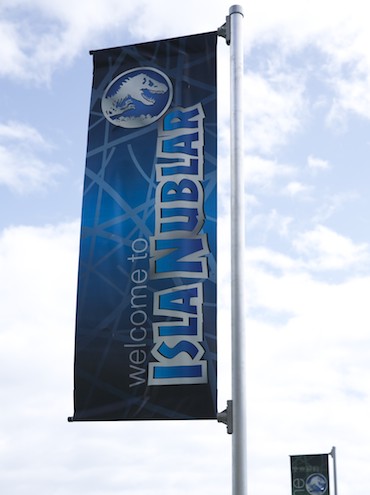
Welcome to Isla Nublar: Raised banners proudly stand tall in welcoming visitors upon their arrival to Jurassic World on Isla Nublar.
Soon after the acquisition of InGen in 1998, Simon Masrani looked to work at a plan that seemed impossible given the circumstances of the years preceding - the control and re-invention of a new theme park on Isla Nublar. Experts from the Masrani company were collected together, along with Dr. Henry Wu from the InGen company, to plan for the greatest theme park and attractions ever constructed in humankind's history.
Simon Masrani used subsidaries Axis Boulder Engineering and Timack Construction to work on the preparation and planning prior to construction on the island. Construction workers were protected from native wildlife by InGen security over the course of the three years from 2002 until completion in 2004. With over $1.2 billion alone spent in concrete and building materials, this project was never underestimated.
"The most incredible thing about the project for me was the fact that we were able to construct so far off the mainland, while maintaining all deadlines", explains Jurassic World Project Manager Mr. Eli Jacobs. "The logistics and the planning were just incredible. Security teams, perimeter fencing, scientists, quarantine zones ... it was quite the atmosphere."
Simon Masrani was taking no chance.
Simon adds, "The sense of security proved vital in the establishment of Jurassic World. The media were having a frenzy at the time, conservation groups around the globe were looking and waiting for any incident to tarnish our reputation to try and take Isla Nublar away from us. We had to set a feeling of safety, for when the time came for opening in 2005, we had to ensure people were willing to come."
And come they did ... Jurassic World officially opened in June 2005 to an incredible 98,120 visitors in its first month of operation.

New concepts unveiled: Claire Dearing, Senior Assets Manager at Jurassic World, speaks from Isla Nublar, Costa Rica.
Masrani’s flagship enterprise opened in 2005 to record-breaking numbers. A state-of-the-art theme park and biological preserve, it has lead the way in entertainment, education and scientific discovery. But what is on the horizon? Claire Dearing, Senior Assets Manager at Jurassic World discusses her thoughts.
"Scientists are often challenged by the risks involved in executing grand concepts," explains Claire. "Many at InGen doubted the likelihood of a successful hybrid, but here we are just one month away and she's more than we imagined. We will closely monitor visitor response and gauge the consumer's appetite for future experiences, taking Jurassic World into a new era."
"But as we seek to recreate the past, we can't forget to innovate", Claire adds. "We have several new rides in the conceptual phase with Axis Boulder. Our most evolved, the 'Treetop Gazers', has an ETA sometime in 2018."
Masrani’s flagship enterprise opened in 2005 to record breaking numbers. A state of the art theme park, leading the way for the future of entertainment, education and scientific discoveries.
Step into the prehistoric era and come face to face with some of the greatest animals to ever walk the Earth, the Dinosaurs! Soak in the atmosphere and visit an ecosystem like nothing experienced before. With technologically advanced ride systems, five star restaurants, and a high class golf course, it is full of excitement, spectacle, and will leave an everlasting impression on everyone who visits.
The Masrani company is proud to present the greatest theme park ever built: Jurassic World.
“The most gratifying feeling of the Masrani Company is the global appreciation of our visions and ideas. We have brought together the world’s top minds all under one roof and since 1973 we have conquered things previously thought impossible. We’ve established ourselves in many areas from telecommunications, to genetic research, and defense organizations, landing as the number one in terms of innovation and success. Jurassic World is the sum of everything that came before it.”